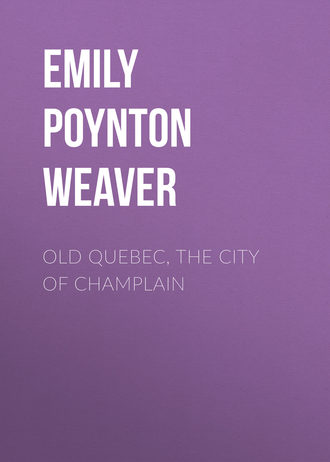 полная версия
полная версияOld Quebec, the city of Champlain
A charm and a glamor hangs over the generally commonplace business of buying and selling, getting gain and making provision for the humble needs of the day. The whole thing seems like a picture-book. The groups of voluble, good-humored habitant women; the queer little carts like ladders mounted on wheels; the small pink pigs, squealing their hardest as they are transferred from the crates of the vendors to the sacks of the purchasers; the background of tall, irregular buildings climbing the great cliff—these lend to the scene a color and character all its own.
Wandering from stall to stall, heaped with vegetables, home-grown tobacco, dark slabs of maple sugar, home-woven towelling curtains or carpets, firmly knit socks, elaborately plaited mats, you begin to wonder at the patience and industry of this vivacious people, and you will wonder at these qualities still more if you see the habitant at home.
Go down, for instance, to Beaupré or St. Joachim, those parishes which Wolfe once so mercilessly harried. It is a fair and fruitful land, well-watered by the “full-fed river,” and over it now seems to brood the gentle angel of peace. Amongst the low curved roofs of the villages rise the towers of great churches, like that at Beauport and the miraculous St. Anne, whither every year come pilgrims in thousands seeking health or peace of mind. Behind these villages, if you step but a little aside from the splendid waterway of the St. Lawrence, you may lose yourself on sparsely-tracked, forest-covered hills, cleft with gullies, down which foam torrents, choked at times with thousands of grinding logs. But, after all, it is only a hermit who would long bury himself amongst these hills.
The winding roads below lead past barns with thatched roofs, log cow-houses with overhanging upper-storeys, cottages with projecting “galleries” and windows shaded with wall-paper, rugged stone houses with huge chimneys, “bake-ovens” under rude shelters of planks, drinking-troughs, wayside crosses, and flowery gardens, containing little shrines, within which glimmer tiny white images of the Virgin and her Son.
Along these roads comes the oddest assortment of vehicles ever seen, I should think, in one district of the Dominion. The habitant carries home his hay in a two-wheeled cart, fitted with a rack and drawn by a rough pony or a yoke of deliberate oxen; and he rides to church or market in a springless conveyance, which is a kind of grotesque compromise between a “top-buggy” and a “buckboard.” When coming from work, however, he contents himself with a humbler vehicle, rattling down the stony slopes at a surprising pace in a little cart drawn by a lean, rough-coated, stout-limbed dog.
A little farther along the same road you may see a stray automobile, while on the other side of the fence run the electric cars of the Quebec Railway Light & Power Company, or occasionally, on the same line, a train of “steam-cars.”
All the country near Quebec is well supplied now with railroads, and the townsfolk are learning to follow the modern fashion of living in country cottages during the summer months. Quebec merchants leave the city by the evening trains to spend their leisure hours with their families at Charlesbourg, Lorette, Montmorency, or some equally interesting but till lately inaccessible place. Others take the small modern steamboats which ply up and down the shores of the St. Lawrence, or to and from the beautiful Island of Orleans, and which have to make their way carefully past great rafts of lumber, fleet “ocean greyhounds,” or quaint barges of the same pattern as those used by Wolfe in his attack upon Quebec. These newcomers into the country bring new fashions, which in course of time will have their effect upon the habitants; but their influence is as yet scarcely perceptible.
Women in broad-brimmed straw hats are still seen in the hay-fields at work beside the men, yet they find time for much labor at loom and spinning-wheel, besides keeping well scrubbed and scoured the old floors and simple furniture, which have rendered good service to their mothers and grandmothers before them.
Ask the age of some cottage heirloom—some gaunt old clock or cumbrous chair—and its owner with a smile and a shrug will assure you, vaguely, “It’s ancient, very ancient.”
You do not doubt the assertion; you only wonder how this corner of the restless New World came to have such persistent, all-pervading regard for the past. So many things are “very ancient” in Quebec; yet it is full of its own characteristic life, this once-French city, which has been British for half its three hundred years of history.
THE END



